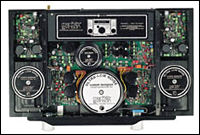| Columns Retired Columns & Blogs |
Mark Levinson No.32 Reference preamplifier Page 2
The 400Hz oscillators supply individual left- and right-channel isolation transformers, followed by rectifiers and discrete DC voltage regulators. The outputs supply clean, stable 400Hz power in the adjacent left and right "towers" capping the Controller. Each tower, machined from a solid block of aluminum, contains the power supply for its respective audio channel. An isolation transformer mounted inside the block further decouples the audio-regulation stages from the 400Hz oscillator amplifier. Soft-recovery diodes rectify and filter the transformer's output, which is then regulated with a low-noise, high-speed voltage regulator designed specifically for the task. Separate cables supply the DC output to each channel. While 2m DC cables are supplied with each unit, lengths of up to 8m are available to expand placement options; a nice touch.
Microprocessor control
 While microprocessors offer lots of flexibility, they're typically noisy little buggers that can pollute low-level audio signals. In the No.32, aside from being located in the separate Controller chassis, the controller module itself (and its microprocessors) sits in a shielded enclosure that is easily removable for hardware updates. In addition to communications, the No.32's microprocessors control volume, signal routing, and other switching functions.
While microprocessors offer lots of flexibility, they're typically noisy little buggers that can pollute low-level audio signals. In the No.32, aside from being located in the separate Controller chassis, the controller module itself (and its microprocessors) sits in a shielded enclosure that is easily removable for hardware updates. In addition to communications, the No.32's microprocessors control volume, signal routing, and other switching functions.
The lucky audiophile using a No.32 can easily name inputs, select mono modes, set mute level, or program gain offset and overall level for individual inputs from the front panel or remote. And, miracle of miracles, you can actually adjust phono loading during play, via the remote or at the front panel! When ML trumpets that cartridge loading has never been simpler or easier, they're not just whistlin' Dixie! Man, that's luxury. Just think of it—you can tune each LP during play, with hardly any effort, from the comfort of your listening chair. Ahhh...pay your big bucks, get spoiled.
Communications
Despite its purist two-channel status, the No.32 Reference participates at the high level of intercomponent communication that is central to the Mark Levinson systems philosophy. Like other recent ML products, the No.32 is built around a software-based operating system that can be upgraded without even opening the chassis: New operating-system software can be downloaded into the preamp via its RS-232 port. That also allows AMX, Crestron, and other, similar multi-zone control systems to communicate with the unit. The three 3.5mm mini-jacks on the rear panel offer DC trigger output (5-12VDC, pulse or level), DC trigger input, and remote IR input control. Two PHAST communications ports offer forward-compatibility with future ML products, as well as other PHAST-equipped components and systems. A separate amplifier control connector provides communications to the No.33 and No.33H amplifiers, as well as to the 300 series amplifiers, if you've got them.
While I didn't make use of these communications subsystems, their very existence suggests the thoroughness and depth of engineering lavished on the No.32—right down to the elegant pair of white gloves packed with each preamplifier.
User interface
The No.32's user interface is a miracle of thoroughness, finesse, and ease of use. The preamp itself has no buttons—just an LED to tell you it's awake. The electromechanical isolation surrounding each of the Controller section's unused inputs allows it to be programmed to act as a dedicated preamp for each individual input source. The two inviting, soft-hued knobs jutting from the Controller's towers set volume and perform input selection. Secondary functions like balance, mute, and selection of recording source are accessed via small buttons ranged along the bottom of the central panel. Parameters for optimum performance for each source can be input, adjusted, and saved. The source selector toggles only among active inputs; ie, it presents only those sources actually connected to the system. Each source can be named in the alphanumeric display, and full control of all functions, with the addition of mono/stereo selection and polarity control, is available from the remote. The remote itself is a nicely designed, ergonomic hunk that's easy to use and falls beautifully to hand.
The preamplifier chassis' casework gives the lucky user something of a visceral thrill. It's a custom aluminum casting, machined and finished with a coating of conductive Irridite (clear chromate). This, per Madrigal, ensures a rigid, stable environment in which vibration and microphonic effects are well controlled. The left and right channels are separated by a solid aluminum divider wall (part of the casting), which seals each channel into its own environment. This prevents one channel's electromagnetic noise from degrading the other channel's signal. Since each channel is effectively isolated electrically and physically, the No.32's stereo separation is equivalent, Madrigal claims, to that of two separate mono preamplifiers.
- Log in or register to post comments




































